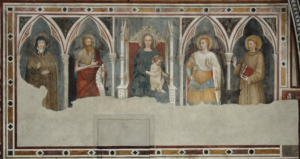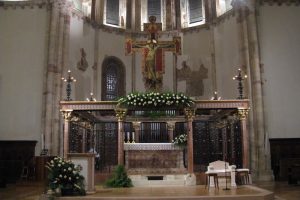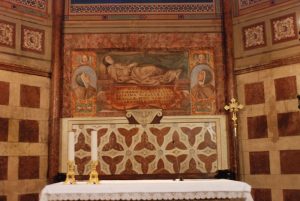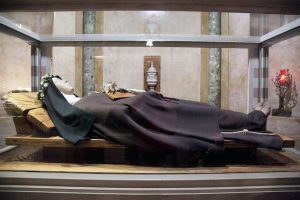Simple guide of the Basilica
Welcome to the Basilica of Saint Clare in Assisi
This is the church that the faith and popular piety have erected in honor of the first and most faithful disciple of Saint Francis. The Basilica was built next to the ancient church of San Giorgio, the site of the first burial of both Saint Francis in 1226 and Saint Clare in 1253.
The construction of the Basilica and the Monastery next to it began in 1257, two years after the canonization of Clare. The body of the Saint was placed under the high altar on 3 October 1260. The solemn consecration of the Basilica was celebrated in 1265.
The typical facade, like the whole basilical complex, is embellished on the outside with alternating strips of white and pink stone from Subasio. Three large arches built at the end of 1300 are visible to the left of the building. The interior of the Basilica, which once had to be entirely frescoed, is linear and clear in its Gothic structure with a Latin cross and a single nave ending in a transept with a polygonal apse.
![]() From the right side of the nave you enter the Chapel of Saint George. Here is kept the precious Crucifix, which spoke to the young Francis in the church of San Damiano. It’s a Byzantine-style shaped icon from the 12th century.
From the right side of the nave you enter the Chapel of Saint George. Here is kept the precious Crucifix, which spoke to the young Francis in the church of San Damiano. It’s a Byzantine-style shaped icon from the 12th century.
In 1205, praying before this crucifix, Saint Francis received the call to work for the Church of the Lord: “Go Francis, repair my house which, as you see, is falling into ruin”. He first interpreted the voice of Christ as a request for the material restoration of the church of San Damiano and only later understood that the Lord called him to work for the Church made of living stones.
 Behind the crucifix the chapel is adorned with fourteenth-century frescoes, including the Majesty of Puccio Capanna (1335): it depicts the Virgin enthroned with the Child blessing, on the left Saint Clare and Saint John the Baptist and on the right Saint Michael the Archangel and Saint Francis. The choir opens behind the grate on the right side, it is the place of prayer of the Poor Clares sisters.
Behind the crucifix the chapel is adorned with fourteenth-century frescoes, including the Majesty of Puccio Capanna (1335): it depicts the Virgin enthroned with the Child blessing, on the left Saint Clare and Saint John the Baptist and on the right Saint Michael the Archangel and Saint Francis. The choir opens behind the grate on the right side, it is the place of prayer of the Poor Clares sisters.
 The main altar is surrounded by a pergola of 12 polygonal columns, the work of an Umbrian stonemason of the fourteenth century, with a wrought iron railing of medieval times.
The main altar is surrounded by a pergola of 12 polygonal columns, the work of an Umbrian stonemason of the fourteenth century, with a wrought iron railing of medieval times.
Above the high altar stands the grandiose cross of Mother Benedetta (1260), attributed to the so-called “Master of Santa Chiara”, who is also said to be the author of the panel of St. Clare and that of the Madonna della Cortina. At the feet of Christ there are adoring Francis and Clare and the abbess Benedetta who commissioned the work.
In the left arm of the transept there is the Altarpiece of Saint Clare (Clare indicating the cross: Christ and around eight scenes of her life, 1283). On the back wall, a very delicate nativity scene of the Umbrian-Sienese school of the fourteenth century is painted. In the lunettes there are scenes from the Old Testament (late thirteenth century).
In the right arm of the transept there is the Altarpiece of the Madonna and Child (Madonna della Cortina, second half of the thirteenth century). There are frescoes always referring to Saint Clare (death and funeral of the saint), and biblical scenes of the Expressionist Master of Saint Clare (first half of the fourteenth century).
The same author probably frescoed also the four lunettes of the cross vault above the altar, which depict the “feminine” celestial glory . In each sail two virgin saints are painted, each standing inside a marble aedicule with the name written below. In the sail towards the apse you can see the Virgin Mary and Saint Clare; in the southern sail there are Saint Cecilia and Saint Lucia; in the sail towards the nave you see Saint Agnes martyr and Saint Agnes of Assisi; in the northern sail there are Saint Catherine of Alexandria and Saint Margaret.
 Near the transept, on the left, there is the Chapel of Saint Agnes, now the Chapel of the Blessed Sacrament. It is accessed by a large ogival arch, scaled down by a stone balustrade, equipped with a wrought iron fence. Here are buried Saint Agnes and Beatrice, sisters of Saint Clare, Mother Ortolana, her cousin Amata and mother Benedetta, first abbess after St. Clare.
Near the transept, on the left, there is the Chapel of Saint Agnes, now the Chapel of the Blessed Sacrament. It is accessed by a large ogival arch, scaled down by a stone balustrade, equipped with a wrought iron fence. Here are buried Saint Agnes and Beatrice, sisters of Saint Clare, Mother Ortolana, her cousin Amata and mother Benedetta, first abbess after St. Clare.
 From the stairs, located at the level of the second span of the Basilica, you can access the crypt. It was built in 1852-1872, renovated in 1935 in neo-Gothic forms, it houses the mortal remains of St. Clare, venerated in a simple urn of white and pink stone of Subasio. The environment where the Franciscan-Clarian relics are exposed have been recently built. The body of St. Clare, found under the high altar in 1850, is the heart of this place. Clare, who made herself a prayer in her life, today intercedes with the Father for her daughters and her sons. For her merits a new breath of the Spirit brings relief to the broken and humiliated heart of every man.
From the stairs, located at the level of the second span of the Basilica, you can access the crypt. It was built in 1852-1872, renovated in 1935 in neo-Gothic forms, it houses the mortal remains of St. Clare, venerated in a simple urn of white and pink stone of Subasio. The environment where the Franciscan-Clarian relics are exposed have been recently built. The body of St. Clare, found under the high altar in 1850, is the heart of this place. Clare, who made herself a prayer in her life, today intercedes with the Father for her daughters and her sons. For her merits a new breath of the Spirit brings relief to the broken and humiliated heart of every man.
May the Lord give you peace!